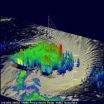(Press-News.org) A neutron star is the closest thing to a black hole that astronomers can observe directly, crushing half a million times more mass than Earth into a sphere no larger than a city. In October 2010, a neutron star near the center of our galaxy erupted with hundreds of X-ray bursts that were powered by a barrage of thermonuclear explosions on the star's surface. NASA's Rossi X-ray Timing Explorer (RXTE) captured the month-long fusillade in extreme detail. Using this data, an international team of astronomers has been able to bridge a long-standing gap between theory and observation.
"In a single month from this unique system, we have identified behavior not seen in observations of nearly 100 bursting neutron stars during the past 30 years," said Manuel Linares, a postdoctoral researcher at the Kavli Institute for Astrophysics and Space Research at the Massachusetts Institute of Technology in Cambridge. He led a study of the RXTE data that will be published in the March 20 issue of The Astrophysical Journal.
On Oct. 10, 2010, the European Space Agency's INTEGRAL satellite detected a transient X-ray source in the direction of Terzan 5, a globular star cluster about 25,000 light-years away toward the constellation Sagittarius. The object, dubbed IGR J17480�, is classed as a low-mass X-ray binary system, in which the neutron star orbits a star much like the sun and draws a stream of matter from it. As only the second bright X-ray source to be found in the cluster, Linares and his colleagues shortened its moniker to T5X2.
Three days after the source's discovery, RXTE targeted T5X2 and detected regular pulses in its emission, indicating that the object was a pulsar -- a type of neutron star that emits electromagnetic energy at periodic intervals. The object's powerful magnetic field directs infalling gas onto the star's magnetic poles, producing hot spots that rotate with the neutron star and give rise to X-ray pulses. At NASA's Goddard Space Flight Center in Greenbelt, Md., RXTE scientists Tod Strohmayer and Craig Markwardt showed that T5X2 spins at a sedate -- for neutron stars -- rate of 11 times a second. And because the pulsar's orbital motion imparts small but regular changes in the pulse frequency, they showed that the pulsar and its sun-like companion revolve around each other every 21 hours.
That same day, RXTE observed its first burst from the system: an intense spike in X-rays lasting nearly 3 minutes and caused by a thermonuclear explosion on the neutron star's surface. Ultimately, RXTE cataloged some 400 events like this between Oct. 13 and Nov. 19, with additional bursts observed by INTEGRAL and NASA's Swift and Chandra observatories. NASA decommissioned RXTE on Jan. 5, 2012.
In the T5X2 system, matter streams from the sun-like star to the neutron star, a process called accretion. Because a neutron star packs more than the sun's mass into a sphere between 10 and 15 miles across -- about the size of Manhattan or the District of Columbia -- its surface gravity is extremely high. The gas rains onto the pulsar's surface with incredible force and ultimately coats the neutron star in a layer of hydrogen and helium fuel. When the layer builds to a certain depth, the fuel undergoes a runaway thermonuclear reaction and explodes, creating intense X-ray spikes detected by RXTE and other spacecraft. The bigger the blast, the more intense its X-ray emission.
Models designed to explain these processes made one prediction that had never been confirmed by observation. At the highest rates of accretion, they said, the flow of fuel onto the neutron star can support continuous and stable thermonuclear reactions without building up and triggering episodic explosions.
At low rates of accretion, T5X2 displays the familiar X-ray pattern of fuel build-up and explosion: a strong spike of emission followed by a long lull as the fuel layer reforms. At higher accretion rates, where a greater volume of gas is falling onto the star, the character of the pattern changes: the emission spikes are smaller and occur more often.
But at the highest rates, the strong spikes disappeared and the pattern transformed into gentle waves of emission. Linares and his colleagues interpret this as a sign of marginally stable nuclear fusion, where the reactions take place evenly throughout the fuel layer, just as theory predicted.
"We see T5X2 as a 'model burster,' the one that's doing everything expected of it," said Diego Altamirano, an astrophysicist at the University of Amsterdam in The Netherlands and a co-author on the paper describing the findings.
The question now before the team is why this system is so different from all others studied in previous decades. Linares suspects that T5X2's slow rotation may hold the key. Faster rotation would introduce friction between the neutron star's surface and its fuel layers, and this frictional heat may be sufficient to alter the rate of nuclear burning in all other bursting neutron stars previously studied.
INFORMATION:
NASA's RXTE captures thermonuclear behavior of unique neutron star
2012-03-12
ELSE PRESS RELEASES FROM THIS DATE:
NASA sees cyclone Irina weaker in Mozambique Channel
2012-03-12
Cyclone Irina has lived a long life and caused a lot of trouble, damages and death over the course of its life, and it appears to be finally fading over the Mozambique Channel.
On March 8 at 1500 UTC (10 a.m. EST), Irina's winds had finally dropped below 45 knots (51.7 mph/83.3 kph) to 35 knots (40.2 mph/64.8 kph) making it a minimal tropical storm. Irina was still in the southern Mozambique Channel, centered near 29.5 South and 37.8 East. That is about 350 miles southeast of Maputo, Mozambique. Irina is moving to the west at 8 knots (9.2 mph/14.8 kph).
The Moderate ...
NASA's TRMM satellite sees hot towers in Cyclone Koji
2012-03-12
Hot towers, or towering thunderclouds that give off an excessive amount of latent heat, usually indicate a tropical cyclone will strengthen in six hours, and NASA's TRMM satellite saw some of them as it passed by Tropical Storm Koji.
The Tropical Rainfall Measuring Mission (TRMM) satellite passed directly above an intensifying tropical storm in the South Indian Ocean called Koji on March 8, 2012 at 2053 UTC (3:53 p.m. EST). A rainfall analysis was made from TRMM Microwave Imager (TMI) and Precipitation Radar (PR) data. Those TRMM data reveal that Koji was getting organized ...
Protecting Our Clients - Michael T. Norris, Ltd. and John W. Callahan, Ltd., Illinois Criminal Defense Law Firm
2012-03-12
At the law offices of Michael T. Norris, Ltd. and John W. Callahan, Ltd., we know how to fight for the rights of the accused. After his arrest by the Hanover Park Police Department, our client was facing a difficult situation. The officers who stopped him claimed they could smell a strong odor of alcohol coming from his breath. They noted that his eyes were watery, glassy and bloodshot. Our client admitted to police that he had consumed alcohol at a local bar over the course of the evening. He later took a breath test which yielded a blood alcohol content of 0.17.
Upon ...
Mount Sinai researchers identify promising new drug target for kidney disease
2012-03-12
Researchers from Mount Sinai School of Medicine have identified a regulator protein that plays a crucial role in kidney fibrosis, a condition that leads to kidney failure. Finding this regulator provides a new therapeutic target for the millions of Americans affected by kidney failure. The research is published in the March 11 issue of Nature Medicine.
Led by John Cijiang He, MD, PhD, Professor of Nephrology and Pharmacology and Systems Therapeutics; and Avi Ma'ayan, PhD, Assistant Professor of Pharmacology and Systems Therapeutics at Mount Sinai School of Medicine, the ...
Experts: Integrate global water, food and energy policies to divert future conflict
2012-03-12
MARSEILLES, FRANCE -- As food and energy production intensify around the world, their demands on dwindling water resources have prompted the search for an innovative and collaborative solution. On Friday, March 16, a High Level Panel convened by the EDF Group and the CGIAR Challenge Program on Water and Food (CPWF) will gather in Marseilles at the Sixth World Water Forum (WWF6) to share experiences and results.
The panel will discuss how to embrace a "nexus" approach to water management, in which projects that tap water resources are planned and executed with input from ...
Discovery could reduce chemo's side effects
2012-03-12
DURHAM, N.C. – A team of researchers at Duke University has determined the structure of a key molecule that can carry chemotherapy and anti-viral drugs into cells, which could help to create more effective drugs with fewer effects to healthy tissue.
"Knowing the structure and properties of the transporter molecule may be the key to changing the way that some chemotherapies, for example, could work in the body to prevent tumor growth," said senior author Seok-Yong Lee, Ph.D., assistant professor of biochemistry at Duke.
The article was published in Nature online on ...
World breakthrough on salt-tolerant wheat
2012-03-12
A team of Australian scientists has bred salt tolerance into a variety of durum wheat that shows improved grain yield by 25% on salty soils.
Using 'non-GM' crop breeding techniques, scientists from CSIRO Plant Industry have introduced a salt-tolerant gene into a commercial durum wheat, with spectacular results shown in field tests. Researchers at the University of Adelaide's Waite Research Institute have led the effort to understand how the gene delivers salinity tolerance to the plants.
The research is the first of its kind in the world to fully describe the improvement ...
Greenland ice sheet may melt completely with 1.6 degrees global warming
2012-03-12
The Greenland ice sheet is likely to be more vulnerable to global warming than previously thought. The temperature threshold for melting the ice sheet completely is in the range of 0.8 to 3.2 degrees Celsius global warming, with a best estimate of 1.6 degrees above pre-industrial levels, shows a new study by scientists from the Potsdam Institute for Climate Impact Research (PIK) and the Universidad Complutense de Madrid. Today, already 0.8 degrees global warming has been observed. Substantial melting of land ice could contribute to long-term sea-level rise of several meters ...
Tracing the UK's No. 1 sexually transmitted infection
2012-03-12
In a study released today in Nature Genetics, researchers have found that Chlamydia has evolved more actively than was previously thought. Using whole genome sequencing the researchers show that the exchange of DNA between different strains of Chlamydia to form new strains is much more common than expected.
The team highlights that current clinical testing methods do not capture the variation between Chlamydia strains. Changes to the genome structure are not the aim of current diagnostics for Chlamydia. The researchers are working with hospitals to use their results ...
Study: Hospitals Attempt to Bury Evidence of Medical Malpractice
2012-03-12
Hospitals in Arizona and across the country are burying their mistakes, according to a new study recently released by U.S. Department of Health and Human Services Inspector General Daniel R. Levinson. The study found that 15,000 Medicare patients die every month in part due to inadequate treatment in hospitals. The types of medical malpractice detailed in the study are gruesome and include surgical fires, objects left inside patients after surgery and surgeries performed on the wrong patients. If your loved one has died due to hospital negligence, you need to speak with ...


